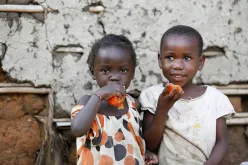In Uganda, UNICEF and the Government are collaborating in pursuit of zero hunger. Their goal? To incorporate nutrition in the country’s health and essential medicine systems. Ayako Okamura, UN Volunteer Nutrition Supply Chain Officer, worked closely with the Ministry of Health on integrating nutrition supplies in the national health system.
Undernutrition is an important contributor to poor maternal, newborn and child survival and development in Uganda. Stunting (low height for age) and wasting (low weight for height) are key indicators of childhood malnutrition and are the result of chronic or recurrent undernutrition.
Both conditions are usually associated with poverty, poor maternal health and nutrition and/or inappropriate feeding and care in early life. Both indicators prevent children from reaching their physical and cognitive potential.
While prevalence of stunting in Uganda decreased from 33 per cent to 29 per cent between 2011 and 2016, there are an estimated 1.8 million stunted children in the country. During the same period, wasting has been mostly stagnant with a small decline from 5 per cent to 4 per cent. There are significant variations among regions in Uganda, whereby wasting is the highest in the regions with emergencies or chronic and cyclical drought.
To support the improvement of health and nutrition service delivery, UNICEF is focusing its efforts on strengthening systems at both national and district levels. UNICEF provides the government with system support inputs and procurement of nutrition supplies, such as therapeutic supplies for the treatment of severe acute malnutrition, Vitamin A supplements, deworming tablets, iron and folic acid, and anthropometric equipment.
Ayako Okamura joined UNICEF as a UN Volunteer Nutrition Supply Chain Officer in April 2018. She served through the Global Human Resource Development Programme for Peacebuilding and Development (HRD) of the Government of Japan.
Ayako’s role was to support the Ministry of Health to integrate and strengthen nutrition supply chains in the country and to manage and optimize nutrition supply chains operated by UNICEF.
"Most nutrition supplies in the country are run through UNICEF parallel supply chains, where the goods are procured, stored and distributed by UNICEF to focus districts and regional referral hospitals," Ayako explains. "On the other hand, there is a national supply chain system for essential medicines and health supplies, managed by National Medical Stores (NMS)."
"I worked extensively with the Ministry of Health’s Nutrition Division and Pharmacy Department and the NMS on the nutrition supply chain integration," Ayako says. "In the field, I also worked with District Health Office and health facility staff to ensure appropriate supply chain management for nutrition programmes at respective levels of operation.
She elaborates, "The integration process is not only about handing over supplies and logistics functions to NMS but also about greater integration of nutrition supplies in the national health system."
During my assignment, 65,379 children were admitted to the treatment programme for severe acute malnutrition, an indication of the need that still exists. -- Ayako Okamura, former UN Volunteer Nutrition Supply Chain Officer with UNICEF, Uganda
Coming from the field of supply chain management in the private sector, Ayako says they strengthened and expanded their supply chain management expertise in the public sector, particularly in public health supply chain management. Ayako also learned what it was like to work in the field of development and humanitarian assistance within the UN system.
"The nutrition supply chain integration aims to increase national ownership and sustainability of nutrition programmes by handing over nutrition supplies from UNICEF and other development partners at the national level and allowing the national supply chain mechanism to control them," Ayako explains. "It will take time to achieve the full integration of nutrition supplies and it will require long-term allocation of Government budget to nutrition supplies, dependent on Government priorities."
Ayako’s assignment contributed to SDG2, end hunger, achieve food security and improved nutrition and promote sustainable agriculture.

